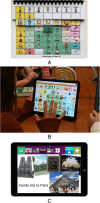Communication in Autistic Adults: An Action-Focused Review
- PMID: 40545515
- PMCID: PMC12271282
- DOI: 10.1007/s11920-025-01616-6
Communication in Autistic Adults: An Action-Focused Review
Abstract
Purpose of review: This review focuses on recent research (primarily published between 2020-2024) describing unique aspects of communication in autistic adults. We review research on communication-related outcomes, as well as four communication topics frequently cited as important to autistic people (literal and non-literal language, augmentative and alternative communication, nonverbal communication, and double empathy).
Recent findings: A substantial proportion of autistic adults do not develop fluent language by adulthood. Autistic adults frequently experience communication barriers impacting relationships, employment, and health. These barriers arise from multiple sources (e.g., language, nonverbal communication, and unaccommodating environments and communication partners). Thus, it is essential to take a multifaceted approach to supporting autistic adults to ensure their communication success. We conclude that it is vital for clinicians and researchers to understand how autistic traits commonly manifest in adults and to accept and accommodate communication differences as they arise. To that end, we offer specific recommendations to help clinicians and researchers strengthen their interactions with the autistic people in their lives.
Keywords: AAC; Autism; Communication; Disability; Language; Nonverbal Communication.
© 2025. The Author(s).
Conflict of interest statement
Declarations. Conflicts of interests: The authors declare no competing interests.
Figures

Similar articles
-
The Lived Experience of Autistic Adults in Employment: A Systematic Search and Synthesis.Autism Adulthood. 2024 Dec 2;6(4):495-509. doi: 10.1089/aut.2022.0114. eCollection 2024 Dec. Autism Adulthood. 2024. PMID: 40018061 Review.
-
Stigma Management Strategies of Autistic Social Media Users.Autism Adulthood. 2025 May 28;7(3):273-282. doi: 10.1089/aut.2023.0095. eCollection 2025 Jun. Autism Adulthood. 2025. PMID: 40539215
-
Integrating Antiracism and Life Course Frameworks in Research with Autistic Minority Transition-Aged Youth and Young Adults.Autism Adulthood. 2025 May 28;7(3):229-237. doi: 10.1089/aut.2023.0088. eCollection 2025 Jun. Autism Adulthood. 2025. PMID: 40539218
-
"In a State of Flow": A Qualitative Examination of Autistic Adults' Phenomenological Experiences of Task Immersion.Autism Adulthood. 2024 Sep 16;6(3):362-373. doi: 10.1089/aut.2023.0032. eCollection 2024 Sep. Autism Adulthood. 2024. PMID: 39371355
-
Music therapy for autistic people.Cochrane Database Syst Rev. 2022 May 9;5(5):CD004381. doi: 10.1002/14651858.CD004381.pub4. Cochrane Database Syst Rev. 2022. PMID: 35532041 Free PMC article.
References
-
- Cuneo N, Floyd S, Goldberg AE. Word meaning is complex: Language-related generalization differences in autistic adults. Cognition. 2024;244:105691. - PubMed
-
- Kapp SK, Gillespie-Lynch K, Sherman LE, Hutman T. Deficit, difference, or both? Autism and neurodiversity. Dev Psychol. 2013;49(1):59–71. - PubMed
-
- American Psychiatric Association. Diagnostic and statistical manual of mental disorders. 3rd ed. American Psychiatric Association; 1980.
-
- American Psychiatric Association. Diagnostic and statistical manual of mental disorders. 3rd (revised). American Psychiatric Association; 1987.
Publication types
MeSH terms
LinkOut - more resources
Full Text Sources
Medical
Research Materials

